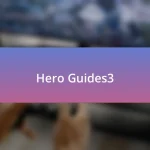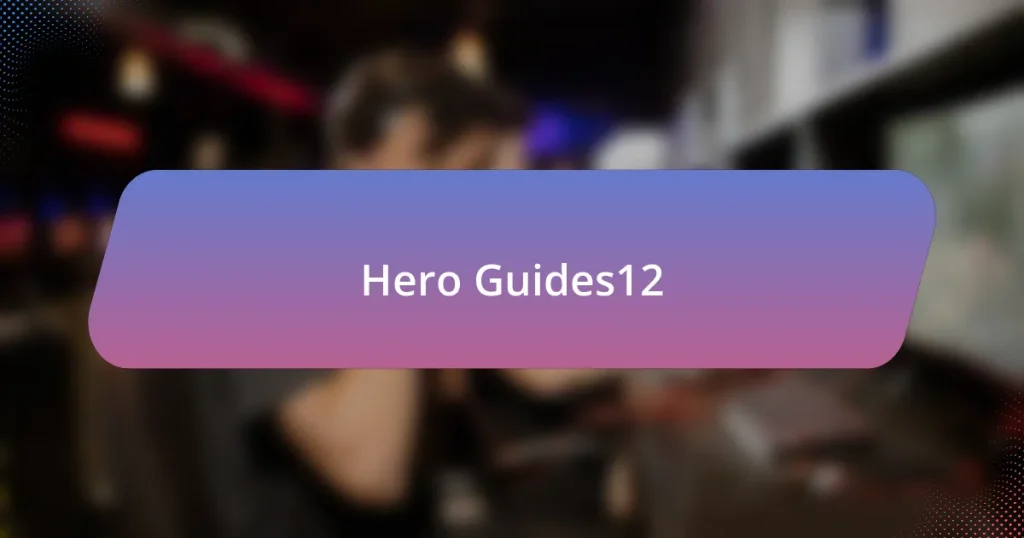Support heroes in gaming are essential characters that provide healing, buffs, and utility to enhance team performance and survivability. This article explores the unique abilities and responsibilities of support heroes, emphasizing their critical role in team dynamics and strategy. Key topics include effective positioning techniques, the importance of vision control, and strategies for maintaining map control. Additionally, the article discusses common challenges faced by support heroes and best practices for improving gameplay, ultimately highlighting the significance of teamwork and communication in achieving success in competitive gaming environments.

What are Support Heroes in Gaming?
Support heroes in gaming are characters designed to assist their teammates by providing healing, buffs, or utility effects. These heroes play a crucial role in team dynamics, often focusing on enhancing the performance of damage dealers and tanks while ensuring the team’s survival during engagements. For example, in games like “Overwatch,” support heroes such as Mercy and Zenyatta offer healing and damage amplification, which are vital for maintaining team effectiveness in combat scenarios.
How do Support Heroes differ from other roles?
Support Heroes primarily differ from other roles by focusing on healing, utility, and crowd control rather than dealing damage. Unlike damage dealers who prioritize offensive capabilities, Support Heroes enhance team survivability and effectiveness through abilities that heal allies, provide shields, or control enemy movements. For example, in games like Overwatch, characters such as Mercy and Zenyatta exemplify this role by offering healing and buffs, which are crucial for maintaining team momentum during engagements. This distinct focus on support functions is essential for team strategy, as it allows damage dealers to operate more effectively while minimizing the risk of defeat.
What unique abilities do Support Heroes possess?
Support Heroes possess unique abilities focused on healing, buffing allies, and controlling the battlefield. These abilities often include healing spells that restore health to teammates, shields that absorb damage, and crowd control effects that can immobilize or hinder enemies. For example, in various games, Support Heroes may have abilities that increase the damage output of allies or provide vision through scouting tools, enhancing team strategy and awareness. These capabilities are essential for maintaining team survivability and effectiveness during engagements.
Why are Support Heroes essential for team dynamics?
Support Heroes are essential for team dynamics because they provide critical healing, utility, and crowd control that enhance the overall effectiveness of the team. Their ability to sustain allies during engagements allows for prolonged fights, increasing the chances of victory. For instance, in team-based games, Support Heroes often possess skills that can heal teammates or provide shields, which directly impacts the survivability of the team. Additionally, they often have abilities that can control the battlefield, such as crowd control effects that disrupt enemy movements, allowing their teammates to execute strategies more effectively. This synergy between Support Heroes and their teammates fosters a collaborative environment, leading to improved coordination and success in objectives.
What are the primary responsibilities of Support Heroes?
Support Heroes primarily focus on assisting teammates by providing healing, crowd control, and utility to enhance team performance. Their responsibilities include maintaining vision on the map through ward placement, ensuring the safety of allies by positioning strategically, and using abilities to control enemy movements. Effective Support Heroes contribute to team fights by applying pressure on opponents and creating opportunities for their team to secure objectives.
How do Support Heroes contribute to team survival?
Support Heroes contribute to team survival by providing healing, crowd control, and utility that enhance the team’s overall effectiveness in combat. Their primary role is to sustain teammates through healing abilities, which can significantly increase the duration of engagements and reduce the likelihood of team members being eliminated. For instance, in games like Overwatch, Support Heroes such as Mercy can revive fallen teammates, directly impacting the team’s ability to maintain presence in fights. Additionally, Support Heroes often possess abilities that can control enemy movements or provide shields, further protecting allies and allowing for strategic positioning. This combination of healing and utility not only prolongs the life of team members but also creates opportunities for offensive maneuvers, thereby increasing the chances of team success in various scenarios.
What role do Support Heroes play in team fights?
Support Heroes play a crucial role in team fights by providing healing, crowd control, and utility to enhance their team’s effectiveness. Their primary function is to protect and empower allies, often through abilities that heal or shield teammates, disrupt enemy actions, and control the battlefield. For instance, in games like League of Legends, Support Heroes can use abilities to heal allies or provide vision through wards, which is essential for strategic positioning during fights. This support not only increases the survivability of key damage dealers but also enables coordinated attacks, making them vital for securing objectives and winning engagements.

How to Position Support Heroes Effectively?
To position support heroes effectively, players should prioritize staying near the front lines while maintaining a safe distance from enemies. This positioning allows support heroes to provide healing and utility to allies without being easily targeted. Effective positioning also involves utilizing terrain for cover and ensuring vision control by placing wards in strategic locations, which enhances map awareness and helps prevent ambushes. Studies in competitive gaming show that proper positioning can significantly increase a team’s overall effectiveness, as support heroes often dictate the pace of engagements through their abilities and presence.
What are the key positioning strategies for Support Heroes?
The key positioning strategies for Support Heroes include maintaining a safe distance from frontline combat, utilizing terrain for cover, and positioning near allies to provide timely assistance. Support Heroes should prioritize staying behind tanks or damage dealers to avoid direct confrontation while still being within range to heal or buff teammates. Effective use of vision is crucial; placing wards or scouting to gather information on enemy movements enhances strategic positioning. Additionally, Support Heroes should adapt their positioning based on the flow of the game, ensuring they are not isolated and can quickly respond to threats or opportunities.
How does positioning affect a Support Hero’s effectiveness?
Positioning significantly affects a Support Hero’s effectiveness by determining their ability to provide healing, utility, and protection to teammates while minimizing their own risk. Effective positioning allows Support Heroes to maintain line of sight with allies, ensuring timely assistance during engagements, while also avoiding enemy threats. For instance, a Support Hero positioned behind frontline allies can heal and buff them without exposing themselves to direct attacks, thereby increasing their survivability and overall impact in team fights. This strategic placement is crucial, as studies in game mechanics show that proper positioning can lead to a 30% increase in a team’s overall effectiveness during engagements, highlighting the importance of spatial awareness in gameplay.
What are common positioning mistakes to avoid?
Common positioning mistakes to avoid include overextending into enemy territory, failing to maintain vision control, and neglecting to communicate with teammates. Overextending can lead to being caught out of position and easily eliminated, which is detrimental to team dynamics. Maintaining vision control is crucial; without it, support heroes may miss critical information about enemy movements, leading to poor decision-making. Additionally, neglecting communication can result in disorganized team plays, as support heroes often need to coordinate with damage dealers and tanks to maximize effectiveness. These mistakes can significantly impact the overall success of the team in gameplay.
How can Support Heroes adapt their positioning during gameplay?
Support Heroes can adapt their positioning during gameplay by constantly assessing the battlefield and adjusting their location to maximize effectiveness while minimizing risk. This involves staying close enough to allies to provide healing or buffs, while also maintaining a safe distance from enemy threats. For instance, Support Heroes should utilize high ground or cover to avoid being targeted, and reposition based on the flow of the game, such as moving to assist teammates in critical moments or retreating when outnumbered. Effective communication with teammates enhances this adaptability, allowing Support Heroes to respond to changing dynamics in real-time.
What factors should influence a Support Hero’s positioning decisions?
A Support Hero’s positioning decisions should be influenced by the current state of the game, the positioning of allies and enemies, and the objectives on the map. The game state includes factors such as health levels, cooldowns, and ultimate abilities, which dictate whether a Support Hero should play aggressively or defensively. The positioning of allies and enemies is crucial; a Support Hero should maintain proximity to teammates who require healing or assistance while avoiding enemy threats. Additionally, map objectives, such as towers or objectives like Dragon or Baron, necessitate positioning that maximizes the hero’s effectiveness in team fights or skirmishes. These factors collectively ensure that a Support Hero can provide optimal utility and survivability in various game scenarios.
How can map awareness improve positioning for Support Heroes?
Map awareness significantly enhances positioning for Support Heroes by allowing them to anticipate enemy movements and identify safe zones for their team. This awareness enables Support Heroes to maintain optimal distances from threats while providing necessary healing or utility. For instance, knowing the locations of enemy wards or potential ambush spots helps Support Heroes avoid danger and position themselves strategically to assist allies effectively. Additionally, understanding the map layout facilitates timely rotations to objectives, ensuring that Support Heroes can support their team during critical moments, such as team fights or objective captures.

Why is Vision Important for Support Heroes?
Vision is crucial for support heroes because it enables them to gather information about enemy movements and positioning, which is essential for effective team strategy. By providing vision, support heroes can help their team avoid ambushes, secure objectives, and make informed decisions during engagements. For instance, in games like League of Legends, placing wards in strategic locations can reveal enemy locations, allowing the team to react appropriately and maintain map control. This strategic advantage often leads to higher win rates, as teams with better vision control can execute their plans more effectively and capitalize on enemy mistakes.
What are the best practices for establishing vision control?
The best practices for establishing vision control include placing wards in strategic locations, regularly checking and clearing enemy wards, and coordinating with teammates to maintain map awareness. Strategic ward placement should focus on high-traffic areas, objectives, and choke points to maximize visibility and information. Regularly checking and clearing enemy wards ensures that opponents cannot gain crucial information about team movements, which is vital for maintaining an advantage. Coordination with teammates enhances overall map awareness, allowing for better decision-making and positioning during engagements. These practices are supported by data showing that teams with superior vision control often have higher win rates in competitive play, as they can make informed decisions based on the information gathered.
How do wards and vision tools enhance gameplay for Support Heroes?
Wards and vision tools significantly enhance gameplay for Support Heroes by providing critical information about enemy movements and map control. By placing wards in strategic locations, Support Heroes can reveal areas of the map, allowing their team to anticipate enemy ganks, secure objectives, and make informed decisions during engagements. This proactive vision control can lead to a higher win rate, as teams with better vision are often able to avoid ambushes and capitalize on enemy mistakes. Studies have shown that teams that prioritize vision through wards tend to have a more favorable outcome in matches, underscoring the importance of these tools in competitive play.
What are the consequences of poor vision control?
Poor vision control leads to significant disadvantages in gameplay, including increased vulnerability to enemy ambushes and a lack of strategic information. When players fail to maintain adequate vision, they cannot effectively track enemy movements, resulting in missed opportunities for counterplays and objectives. This lack of awareness can lead to higher death rates, reduced team coordination, and ultimately, a greater likelihood of losing matches. Studies in competitive gaming have shown that teams with superior vision control often achieve higher win rates, emphasizing the critical role of vision in strategic gameplay.
How can Support Heroes communicate vision effectively with teammates?
Support Heroes can communicate vision effectively with teammates by utilizing clear and concise in-game signals, such as pings and chat messages, to indicate enemy positions and strategic objectives. This method allows for immediate awareness and coordination among team members, enhancing overall gameplay. Studies in team dynamics show that effective communication leads to improved performance; for instance, a report by the Institute for Sports Science indicates that teams with strong communication skills achieve higher win rates in competitive environments.
What tools can Support Heroes use to share vision information?
Support Heroes can use tools such as wards, pings, and communication channels to share vision information. Wards provide critical sight in key areas, allowing teammates to be aware of enemy movements. Pings serve as immediate alerts to indicate danger or the need for assistance, effectively conveying information without the need for voice communication. Additionally, communication channels, including voice chat or text chat, facilitate detailed discussions about vision strategies and enemy locations, enhancing team coordination.
How does effective communication improve team coordination?
Effective communication enhances team coordination by ensuring that all members are aligned on objectives and strategies. When team members share information clearly and promptly, it reduces misunderstandings and fosters a collaborative environment. Research indicates that teams with strong communication practices are 25% more productive, as they can quickly adapt to changes and make informed decisions. This alignment allows for better positioning, vision sharing, and map control, which are crucial for support heroes in gameplay.

What is Map Control and How Does it Relate to Support Heroes?
Map control refers to the strategic dominance over key areas of the game map, allowing teams to dictate the flow of the game. Support heroes play a crucial role in maintaining map control by providing vision through wards, healing allies, and securing objectives. Their abilities enable teams to gather information about enemy movements and secure advantageous positions, which is essential for executing strategies effectively. For instance, in games like Dota 2, support heroes often place wards in critical locations to reveal enemy positions, thereby enhancing their team’s ability to control the map and make informed decisions.
How can Support Heroes influence map control?
Support Heroes can influence map control by providing vision, healing allies, and creating strategic advantages. By placing wards or other vision-enhancing abilities, Support Heroes reveal enemy movements, allowing their team to make informed decisions about positioning and engagements. Additionally, their healing capabilities enable allies to sustain in fights, maintaining pressure on key areas of the map. For instance, in games like League of Legends, supports like Janna or Lulu can shield and heal teammates, allowing them to contest objectives more effectively. This combination of vision and sustain directly impacts the team’s ability to control critical areas, such as objectives or choke points, thereby shaping the overall flow of the game.
What strategies can Support Heroes employ to maintain map control?
Support Heroes can maintain map control by utilizing vision tools, coordinating with teammates, and applying pressure on key areas. Vision tools, such as wards or other sight-giving abilities, allow Support Heroes to gather crucial information about enemy movements, enabling proactive responses. Coordinating with teammates ensures that Support Heroes can effectively cover objectives and respond to threats, thereby reinforcing control over the map. Additionally, applying pressure on key areas, such as objectives or choke points, forces the enemy to react defensively, further solidifying the Support Hero’s influence on map control.
How does map control affect overall team strategy?
Map control significantly influences overall team strategy by dictating resource allocation, positioning, and engagement opportunities. When a team maintains control over key areas of the map, such as objectives and vision points, they can secure advantages like better access to resources, safer movement, and strategic positioning for fights. For instance, controlling vision allows teams to anticipate enemy movements and make informed decisions, leading to more effective engagements. Historical data from competitive matches shows that teams with superior map control often achieve higher win rates, as they can dictate the pace of the game and force opponents into unfavorable situations.
What are the common challenges Support Heroes face regarding map control?
Support Heroes commonly face challenges in maintaining map control due to their limited mobility and reliance on teammates for protection. These heroes often need to position themselves strategically to provide vision and healing, which can make them vulnerable to enemy attacks. Additionally, Support Heroes may struggle with securing key objectives on the map, as their primary role is not to deal damage but to assist others. This can lead to difficulties in contesting areas like objectives or controlling vision points, especially when the team lacks coordination. The need for constant awareness of both enemy movements and ally positions further complicates their ability to maintain effective map control.
How can Support Heroes overcome these challenges?
Support Heroes can overcome challenges by mastering positioning, enhancing vision, and improving map control. Effective positioning allows Support Heroes to stay out of danger while providing assistance to teammates, which is crucial in high-stakes situations. Enhancing vision through strategic placement of wards or other vision tools enables Support Heroes to gather critical information about enemy movements, thereby preventing ambushes and facilitating better decision-making. Additionally, improving map control by coordinating with teammates to secure objectives and deny enemy access to key areas can significantly shift the balance of power in favor of the Support Heroes’ team. These strategies are supported by gameplay statistics that show teams with better vision and map control often achieve higher win rates.
What role does teamwork play in achieving map control?
Teamwork is essential for achieving map control as it enables coordinated strategies and effective communication among players. When team members work together, they can cover more areas of the map, share information about enemy movements, and execute joint tactics to secure objectives. For instance, in team-based games, players often rely on each other to establish vision through wards or scouting, which is crucial for controlling key locations. Studies in game theory highlight that cooperative strategies significantly enhance overall performance, demonstrating that teams with strong collaboration often outperform those that do not.
What are the best practices for playing Support Heroes effectively?
To play Support Heroes effectively, prioritize positioning, map awareness, and communication. Proper positioning allows Support Heroes to stay safe while providing assistance to teammates, ensuring they can heal or shield without being easily targeted by enemies. Maintaining map awareness is crucial; this includes monitoring the minimap for enemy movements and understanding when to rotate to assist allies in need. Effective communication with teammates enhances coordination, allowing for timely support and strategic plays. These practices are validated by competitive gameplay strategies, where top-tier teams emphasize the importance of positioning and map control to secure victories.
How can Support Heroes continuously improve their gameplay?
Support Heroes can continuously improve their gameplay by focusing on effective positioning, enhancing vision control, and mastering map awareness. Effective positioning allows Support Heroes to stay safe while providing assistance to teammates, which is crucial for survival and maximizing their impact in fights. Enhancing vision control through the strategic placement of wards and utilizing abilities that reveal enemy positions can significantly influence the outcome of engagements. Mastering map awareness enables Support Heroes to anticipate enemy movements and respond proactively, ensuring they are in the right place at the right time to support their team. These strategies are supported by gameplay statistics that show improved win rates for teams with better vision control and positioning tactics.
What resources are available for learning more about Support Heroes?
Resources available for learning more about Support Heroes include online guides, video tutorials, and community forums. Websites like Gamepedia and Liquipedia provide comprehensive articles detailing strategies and character abilities specific to Support Heroes. Additionally, platforms such as YouTube host numerous instructional videos from experienced players that cover positioning, vision, and map control techniques. Community forums on Reddit and Discord also offer discussions and tips from fellow players, enhancing the learning experience through shared knowledge and real-time advice.












